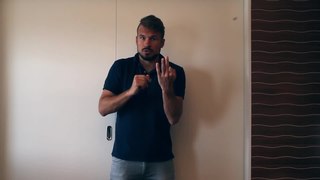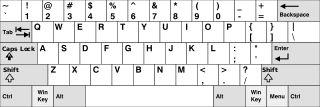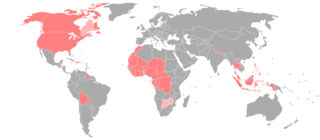
Sign languages are languages that use the visual-manual modality to convey meaning. Sign languages are expressed through manual articulation in combination with non-manual markers. Sign languages are full-fledged natural languages with their own grammar and lexicon. Sign languages are not universal and are usually not mutually intelligible, although there are also similarities among different sign languages.
Shona is a Bantu language of the Shona people of Zimbabwe. It was codified by the colonial government in the 1950s. According to Ethnologue, Shona, comprising the Zezuru, Korekore and Karanga dialects, is spoken by about 7.5 million people. The Manyika dialect of Shona is listed separately by Ethnologue, and is spoken by 1,025,000 people.

French Sign Language is the sign language of the deaf in France and French-speaking parts of Switzerland. According to Ethnologue, it has 100,000 native signers.

Finnish Sign Language is the sign language most commonly used in Finland. There are 3,000 (2012 estimate) Finnish deaf who have Finnish Sign Language as a first language. As the Finnish system records users by their written language, not their spoken alone, nearly all deaf people who sign are assigned this way and may be subsumed into the overall Finnish language figures. Historically the aim was oralism, whereby deaf people were taught to speak oral Finnish, even if they could not hear it; thus older people are recorded under these figures. In 2014, only 500 people registered Finnish Sign Language as their first language. There are several sign languages that come under this label; FSL for those that can see; Signed Finnish, which does not follow the same grammatical rules, and a version for those who are blind and deaf. Thus, there are around 8,000 people that use a Finnish Sign Language linguistically. Many estimates say 5,000, but these are exaggerations derived from the 14,000 deaf people in Finland. Finnish Sign Language is derived from Swedish Sign Language, which is a different language from Finnish Swedish Sign Language, from which it began to separate as an independent language in the middle of the 19th century.

Irish Sign Language is the sign language of Ireland, used primarily in the Republic of Ireland. It is also used in Northern Ireland, alongside British Sign Language (BSL). Irish Sign Language is more closely related to French Sign Language (LSF) than to BSL, though it has influence from both languages. It has influenced sign languages in Australia and South Africa, and has little relation to either spoken Irish or English. ISL is unique among sign languages for having different gendered versions due to men and women being taught it at different schools.

South African Sign Language is the primary sign language used by deaf people in South Africa. The South African government added a National Language Unit for South African Sign Language in 2001. SASL is not the only manual language used in South Africa, but it is the language that is being promoted as the language to be used by the Deaf in South Africa, although Deaf peoples in South Africa historically do not form a single group.
Indo-Pakistani Sign Language (IPSL) is the predominant sign language in the subcontinent of South Asia, used by at least 15 million deaf signers. As with many sign languages, it is difficult to estimate numbers with any certainty, as the Census of India does not list sign languages and most studies have focused on the north and urban areas. As of 2021, it is the most used sign language in the world, and Ethnologue ranks it as the 151st most "spoken" language in the world.
Manually coded languages (MCLs) are a family of gestural communication methods which include gestural spelling as well as constructed languages which directly interpolate the grammar and syntax of oral languages in a gestural-visual form—that is, signed versions of oral languages. Unlike the sign languages that have evolved naturally in deaf communities, these manual codes are the conscious invention of deaf and hearing educators, and as such lack the distinct spatial structures present in native deaf sign languages. MCLs mostly follow the grammar of the oral language—or, more precisely, of the written form of the oral language that they interpolate. They have been mainly used in deaf education in an effort to "represent English on the hands" and by sign language interpreters in K-12 schools, although they have had some influence on deaf sign languages where their implementation was widespread.

Plains Indian Sign Language (PISL), also known as Hand Talk, Plains Sign Talk, and First Nation Sign Language, is a trade language, formerly trade pidgin, that was once the lingua franca across what is now central Canada, the central and western United States and northern Mexico, used among the various Plains Nations. It was also used for story-telling, oratory, various ceremonies, and by deaf people for ordinary daily use. It is thought by some to be a manually coded language or languages; however, there is not substantive evidence establishing a connection between any spoken language and Plains Sign Talk.
Thai Sign Language (TSL), or Modern Standard Thai Sign Language (MSTSL), is the national sign language of Thailand's deaf community and is used in most parts of the country by the 20 percent of the estimated 56,000 pre-linguistically deaf people who go to school. Thai Sign Language was acknowledged as "the national language of deaf people in Thailand" in August 1999, in a resolution signed by the Minister of Education on behalf of the Royal Thai Government. As with many sign languages, the means of transmission to children occurs within families with signing deaf parents and in schools for the deaf. A robust process of language teaching and acculturation among deaf children has been documented and photographed in the Thai residential schools for the deaf.
Portuguese Sign language is a sign language used mainly by deaf people in Portugal.

Many languages are spoken, or historically have been spoken, in Zimbabwe. Since the adoption of its 2013 Constitution, Zimbabwe has 16 official languages, namely Chewa, Chibarwe, English, Kalanga, Koisan, Nambya, Ndau, Ndebele, Shangani, Shona, sign language, Sotho, Tonga, Tswana, Venda, Xhosa. The country's main languages are Shona, spoken by over 70% of the population, and Ndebele, spoken by roughly 20%. English is the country's lingua franca, used in government and business and as the main medium of instruction in schools. English is the first language of most white Zimbabweans, and is the second language of a majority of black Zimbabweans. Historically, a minority of white Zimbabweans spoke Afrikaans, Greek, Italian, Polish, and Portuguese, among other languages, while Gujarati and Hindi could be found amongst the country's Indian population. Deaf Zimbabweans commonly use one of several varieties of Zimbabwean Sign Language, with some using American Sign Language. Zimbabwean language data is based on estimates, as Zimbabwe has never conducted a census that enumerated people by language.

Swedish Sign Language is the sign language used in Sweden. It is recognized by the Swedish government as the country's official sign language, and hearing parents of deaf individuals are entitled to access state-sponsored classes that facilitate their learning of SSL. There are fewer than 10,000 speakers, making the language officially endangered.
Around seven Tanzanian sign languages were developed independently among deaf students in separate Tanzanian schools for the deaf starting in 1963, though use of several are forbidden by their schools. In 1984, a standardized Tanzanian Sign Language was proposed by the Tanzania Association for the Deaf, using common or similar signs where these exist in the schools which allowed research, but it has not been officially implemented, and there remains little influence between the languages. A dictionary has been produced. Lexically, the variety that developed in the oralist deaf school in Tabora is significantly different from the dictionary, and is under investigation.
Greek Sign Language is a sign language used by the Greek deaf community.
The deaf sign language of the nations of the former Yugoslavia, known variously as Croatian Sign Language, Kosovar Sign Language, Serbian Sign Language, Bosnian Sign Language, Macedonian Sign Language, Slovenian Sign Language, or Yugoslav Sign Language (YSL), got its start when children were sent to schools for the deaf in Austro-Hungary in the early 19th century. The first two local schools opened in 1840 in Slovenia and in 1885 in Croatia.
Tunisian Sign Language is the sign language used by deaf people in Tunisia. It derives from Italian Sign Language, mixed with indigenous sign.
Bulgarian Sign Language is the language, or perhaps languages, of the deaf community in Bulgaria.

Finland-Swedish Sign Language (FinSSL) is a moribund sign language in Finland. It is now used only in private settings by older adults who attended the only Swedish school for the deaf in Finland, which was established in the mid-19th century by Carl Oscar Malm but closed in 1993. Some 90 persons have it as their native language. FinSSL is said to be a distinct language; however, "Finland-Swedish Deaf have few problems understanding Finnish signers". There had been, moreover, continuous input from Swedish Sign Language over its history.

American Sign Language (ASL) developed in the United States and Canada, but has spread around the world. Local varieties have developed in many countries, but there is little research on which should be considered dialects of ASL and which have diverged to the point of being distinct languages.









